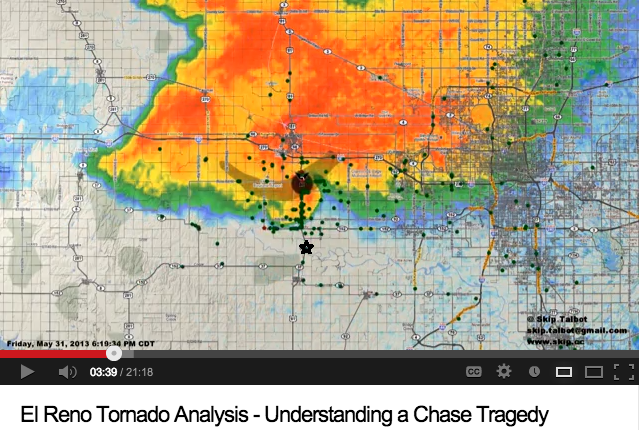Fantastic breakdown of the El Reno tornado. I’m not sure how long this took to put together but MAJOR respect to Skip Talbot for taking the time to offer his perspective.
I was on this storm, too. Pulled from the above video, here is a look at my position relative to the tornadoes position.

As you can see, I was south on Highway 81 and out of the path of the tornado, but managed to get some decent pictures and video.

More pictures taken from my iPhone:
[fsg_gallery id=”2″]
And here is a video that I show students when I go to local schools. You can watch the formation of 0 what researchers found to be – a weak anti-cyclonic tornado on the left-hand side of the tornado.
5/31/2018 UPDATE:
Since this is the five year anniversary, I wanted to update this post with some extra information that researchers, chasers and other meteorologists are posting today…
Five years ago today, an extraordinarily large tornado occurred near El Reno, OK. That tornado, along with flooding that later occurred in the OKC area, killed 21 people. The tornado was observed by several mobile radars, including OU's RaXPol radar. 1/n
— SRHelicity (@SRHelicity) May 31, 2018
Here is a video and a tweet from the National Weather Service in Norman, Oklahoma:
Today we remember 21 people who died on May 31, 2013. Eight people – including a 17 day old infant – were killed in vehicles by the El Reno tornado. Thirteen people – including eight children – died in flooding. Twelve of those were sheltering from the tornado in culverts. pic.twitter.com/KIyihjjAEN
— Rick Smith (@ounwcm) May 31, 2018
Here is a link to the Damage Assessment from the Engineering school at the University of Florida: http://windhazard.davidoprevatt.com/wp-content/uploads/2012/10/El-Reno-Tornado-31-May-2013-Summary-UNIV-FLORIDA.pdf
Here is the ground-based damage assessment from the American Meteorological Society: https://ams.confex.com/ams/27SLS/webprogram/Manuscript/Paper254342/ElReno-FINAL.pdf
Here is some research about how satellite tornadoes work: http://www.spc.noaa.gov/publications/edwards/slssat-t.pdf

